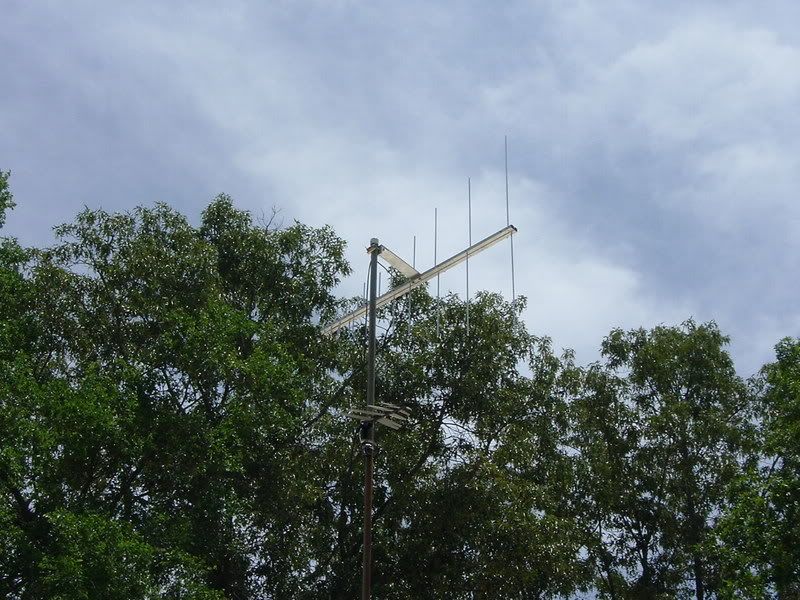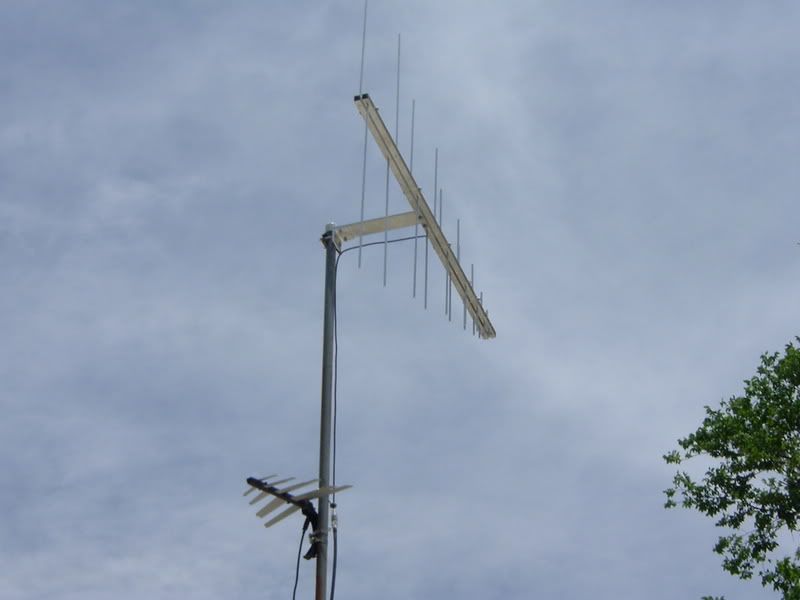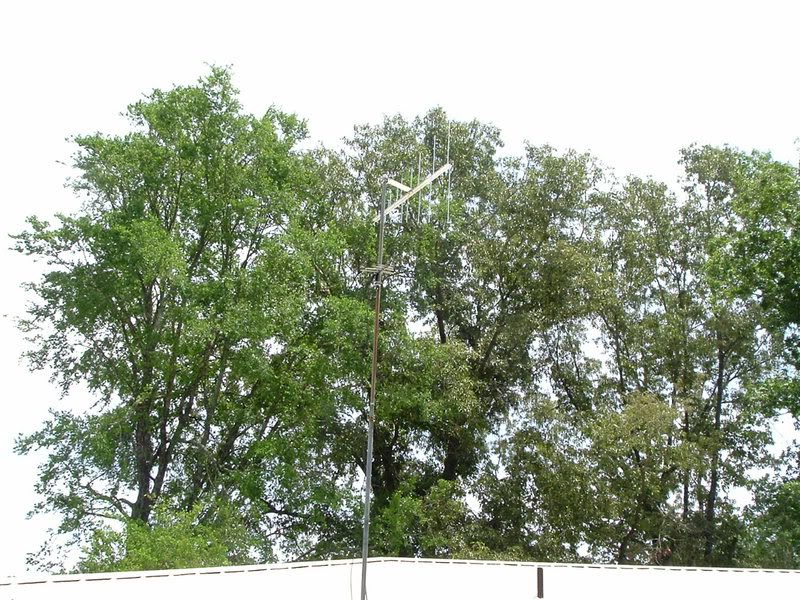radiopro52
Member
After using a RadioShack 20-176 for about a year, and upgrading coax and moving the antenna to a higher mast, I decided I may as well go all the way and upgrade the antenna as well. The 20-176 was actually a good antenna. I was listening to ham repeaters over 100 miles away with it, and police stations that were over 60 miles away. I researched several different antennas, including the scantenna, discones, and the DPD antennas. After reading up on DPD's antennas on this site, I decided that the DPD LP was the best bet. It had the most elements and gain, and it was made in America. My first impressions of the LP antenna follow.
Here's a picture of the antenna installed on my mast.

Looking at the above picture, it looks like the antenna is surrounded by trees, but it's not. I just wanted to get a close shot. I'm going to lower the TV antenna that's located below the LP in the future to get it away from the LP. The LP is mounted about 21.5 feet in the air, using 50 feet of LMR-400 coax attached with an adapter to the LP's RG58.
Here's another view from the other side:

I have the LP pointed north east, as that's where most of my desired signals are coming from (Decatur AL, Huntsville AL, ect.). I can tell that the LP is not as omni-directional as the 20-176. However, it does hear in all directions. The LP does hear signals best in the direction it is pointed, and that's where the gain is. For the most part, the things I listen to that do not come from the north east are received the same way with the LP, compared to the 20-176. An exception is a VHF frequency, which is my county EMS. It came in near full strength with the 20-176, but unfortunetly it only has two bars of signal strength using the LP. It was only one bar, but after the corrections I made, it did make it a little better.
Other than that, in VHF the LP performs very well. Local airports come in stronger, and I am hearing things on a VHF search that I have never heard before. Compared to the 20-176, the LP does a little better in the gain area. However, on some VHF freqencies, it does worse.
UHF is where the LP really outpeforms the 20-176. My local city police's UHF system comes in full signal now. And the "channel 2" frequency of the police station, which was always scratchy and weak before, comes in clear now with a few bars. Ham repeaters in UHF also come in much better. A neighboring county's EMS UHF frequency also comes in stronger. I'm very satisfied with the LP in 400 Mhz.
Finally, there's 800 Mhz. After fixing the mistakes, I have now noticed an improvement in 800 Mhz reception with the LP. The Huntsville trunking system's data channel now comes in, instead of fading in and out. In fact, I think it's safe to say that I do notice an increase in performance in 800 MHz now with the LP compared to the 20-176. The signal is still weak, but that's expected in this band.
I'm using the BCT15 which can listen to FM Radio broadcasts. With the LP, all of my local radio stations come in full signal, and even some that are not local come in at full signal.
The LP is very well-built. The materials obviously aren't cheap, and the antenna was very easy to assemble. Dave is a very nice person to talk to and I'm happy to own one of his antennas. I'm going to continue to experiement with the LP and see what other results I get. If you buy the LP, I recommend installing it with a rotor so you can get the gain in all directions.
So, is there a difference after fixing the problems? Yes. Performance in VHF does seem to have gotten better, and performance in 800 Mhz has increased for sure. So, with the attenna now installed correctly, I will say that I am happy with it's performance. Overall, it does perform better than the 20-176 with a few exceptions. But a rotar would probably make the experience even better, and I may put one on in the future. Here's one last picture of the entire mast:

Here's a picture of the antenna installed on my mast.

Looking at the above picture, it looks like the antenna is surrounded by trees, but it's not. I just wanted to get a close shot. I'm going to lower the TV antenna that's located below the LP in the future to get it away from the LP. The LP is mounted about 21.5 feet in the air, using 50 feet of LMR-400 coax attached with an adapter to the LP's RG58.
Here's another view from the other side:

I have the LP pointed north east, as that's where most of my desired signals are coming from (Decatur AL, Huntsville AL, ect.). I can tell that the LP is not as omni-directional as the 20-176. However, it does hear in all directions. The LP does hear signals best in the direction it is pointed, and that's where the gain is. For the most part, the things I listen to that do not come from the north east are received the same way with the LP, compared to the 20-176. An exception is a VHF frequency, which is my county EMS. It came in near full strength with the 20-176, but unfortunetly it only has two bars of signal strength using the LP. It was only one bar, but after the corrections I made, it did make it a little better.
Other than that, in VHF the LP performs very well. Local airports come in stronger, and I am hearing things on a VHF search that I have never heard before. Compared to the 20-176, the LP does a little better in the gain area. However, on some VHF freqencies, it does worse.
UHF is where the LP really outpeforms the 20-176. My local city police's UHF system comes in full signal now. And the "channel 2" frequency of the police station, which was always scratchy and weak before, comes in clear now with a few bars. Ham repeaters in UHF also come in much better. A neighboring county's EMS UHF frequency also comes in stronger. I'm very satisfied with the LP in 400 Mhz.
Finally, there's 800 Mhz. After fixing the mistakes, I have now noticed an improvement in 800 Mhz reception with the LP. The Huntsville trunking system's data channel now comes in, instead of fading in and out. In fact, I think it's safe to say that I do notice an increase in performance in 800 MHz now with the LP compared to the 20-176. The signal is still weak, but that's expected in this band.
I'm using the BCT15 which can listen to FM Radio broadcasts. With the LP, all of my local radio stations come in full signal, and even some that are not local come in at full signal.
The LP is very well-built. The materials obviously aren't cheap, and the antenna was very easy to assemble. Dave is a very nice person to talk to and I'm happy to own one of his antennas. I'm going to continue to experiement with the LP and see what other results I get. If you buy the LP, I recommend installing it with a rotor so you can get the gain in all directions.
So, is there a difference after fixing the problems? Yes. Performance in VHF does seem to have gotten better, and performance in 800 Mhz has increased for sure. So, with the attenna now installed correctly, I will say that I am happy with it's performance. Overall, it does perform better than the 20-176 with a few exceptions. But a rotar would probably make the experience even better, and I may put one on in the future. Here's one last picture of the entire mast:

Last edited:

